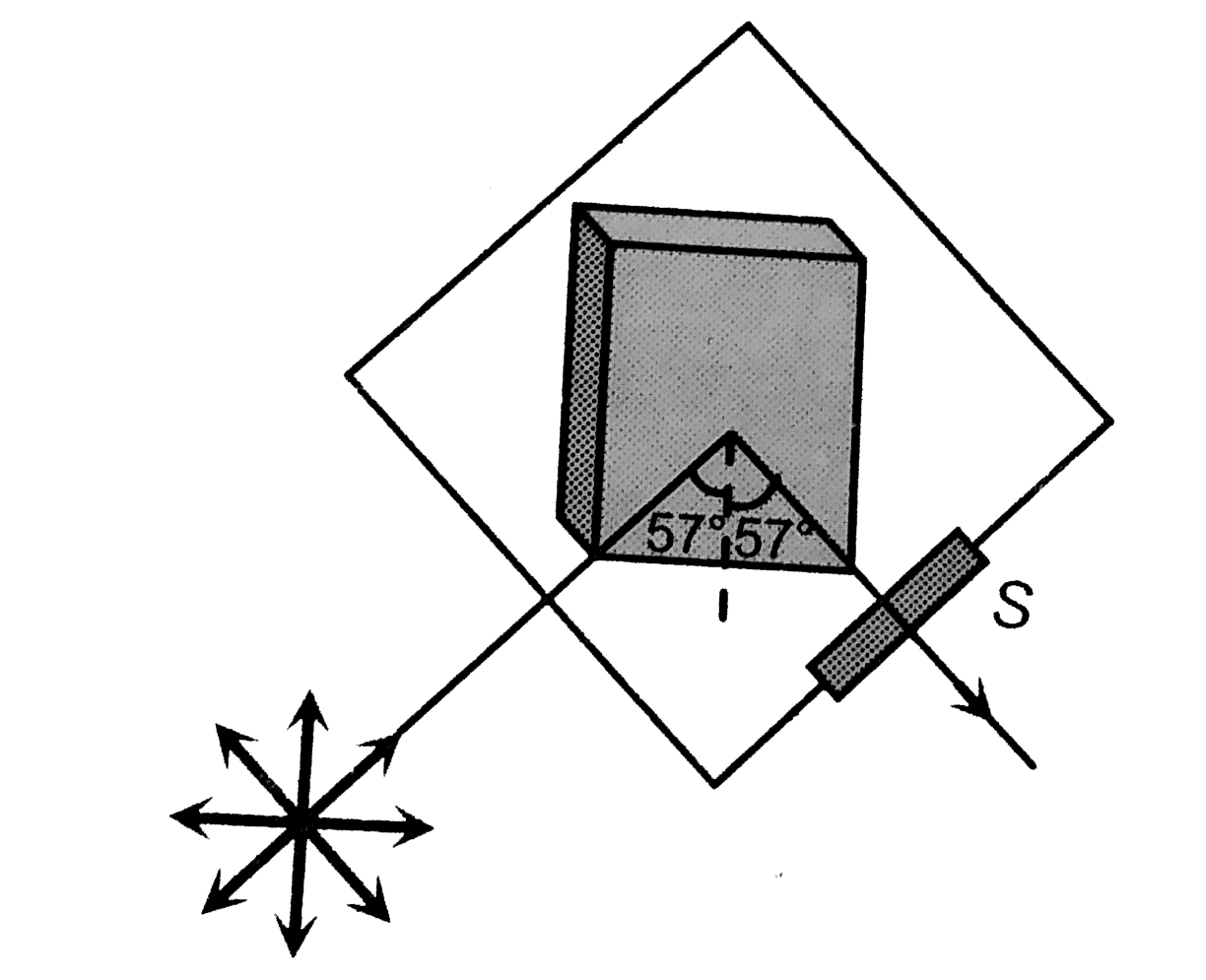Figure represents a glass plate placed vertically on a horizontal table with a beam of unpolarised light falling on its surface at the polarising angle of 57∘ with the normal. The electric vector in the reflected light on screen S will vibrate with respect to the plane of incidence in a

vertical plane
Horizontal plane
Plane making and angle of 45∘ with the vertical
Plane making an angle of 57∘ with the horizontal
The correct Answer is:A
When an unpolarised beam of light is incident on a glass slab at the polarising angle, the reflected beam is completely plane polarised in a plane perpendicular to the plane of incidence. Light is an e.m. wave, in which the →E vector is the dominant vector.
∴→E vector in the reflected light will vibrate w.r.t. the plane of incidence in a vertical plane.
Topper's Solved these Questions
Similar Questions
A ray of light incident normally on a glass slab of refractive index 3/2, travels a distance of 6 cm in glass in time t. What will be the distance travelled by the ray in the same time (t) if it travels in air ?
02:03View SolutionIn a sinusoidal wave, the time required by a particular particle to move from maximum displacement to zero displacement is 0.025 sec. The frequency of the wave is
02:03View SolutionWhen light is incident from air to glass at an angle 57^@ , the reflected beam is completely polarised. If the same beam is incident from water to glass, the angle of incidence at which reflected beam is completely polarised will be
03:49View SolutionFigure represents a glass plate placed vertically on a horizontal table with a beam of unpolarised light falling on its surface at the polarising angle of 57∘ with the normal. The electric vector in the reflected light on screen S will vibrate with respect to the plane of incidence in a
 03:37View Solution
03:37View SolutionAn unpolarised light is incident on a plate of refractive index sqrt(3) and the reflected light is found to be completely plane polarised. The angles of incidence and refraction are respectively
03:27View SolutionA beam of light strikes a glass plate at an angle of incident 60∘ and reflected light is completely polarised than the refractive index of the plate is-
03:26View SolutionA beam of light strikes a surface at angle of incidence of 60∘ and reflected beam becomes completely polarised . The refractive index of glass surface is -
02:27View SolutionA ray of unpolarised light is incident on the surface of a glass plate of refractive index 1.54 at the polarising angle. If tan57∘C=1.54, then the angle of refraction in glass is
02:04View SolutionA ray of unpolarised light is incident on a glass plate at the polarising angle θp. Then
04:17View SolutionWhat is the angle at which a glass plate of refractive index 1.65 is to be kept with respect to the horizontal surface so that an unpolarised light travelling horizontal after reflection from the glass place is found to be plane polarised?
View SolutionFigure represents a glass plate placed vertically on a horizontal table with a beam of unpolarised light falling on its surface at the polarising angle of 57^@ with the normal. The electric vector in the reflected light on screen S will vibrate with respect to the plane of incidence in a
View SolutionWhen a beam of unpolarised light is incident on a glass plate at the polarising angle , then :
02:35View SolutionA ray of unpolarised light in incident on the surface of a glass plate of refractive index 1.54 at the polarising angle. If tan 57∘C = 1.54, then the angle of refraction in glass is :
07:03View SolutionA beam of light strikes a surface at angle of incidence of 60^(@) and reflected beam becomes completely polarised . The refractive index of glass surface is -
View SolutionWhen light is incident from air to glass at an angle 57∘, the reflected beam is completely polarised. If the same beam is incident from water to glass, the angle of incidence at which reflected beam is completely polarised will be
01:14View SolutionA ray of unpolarised light is incident on the surface of a glass plate of μ=1.54, at the polarizing angle. If tan 57∘=1.54, then the angle of refraction is
View Solution

